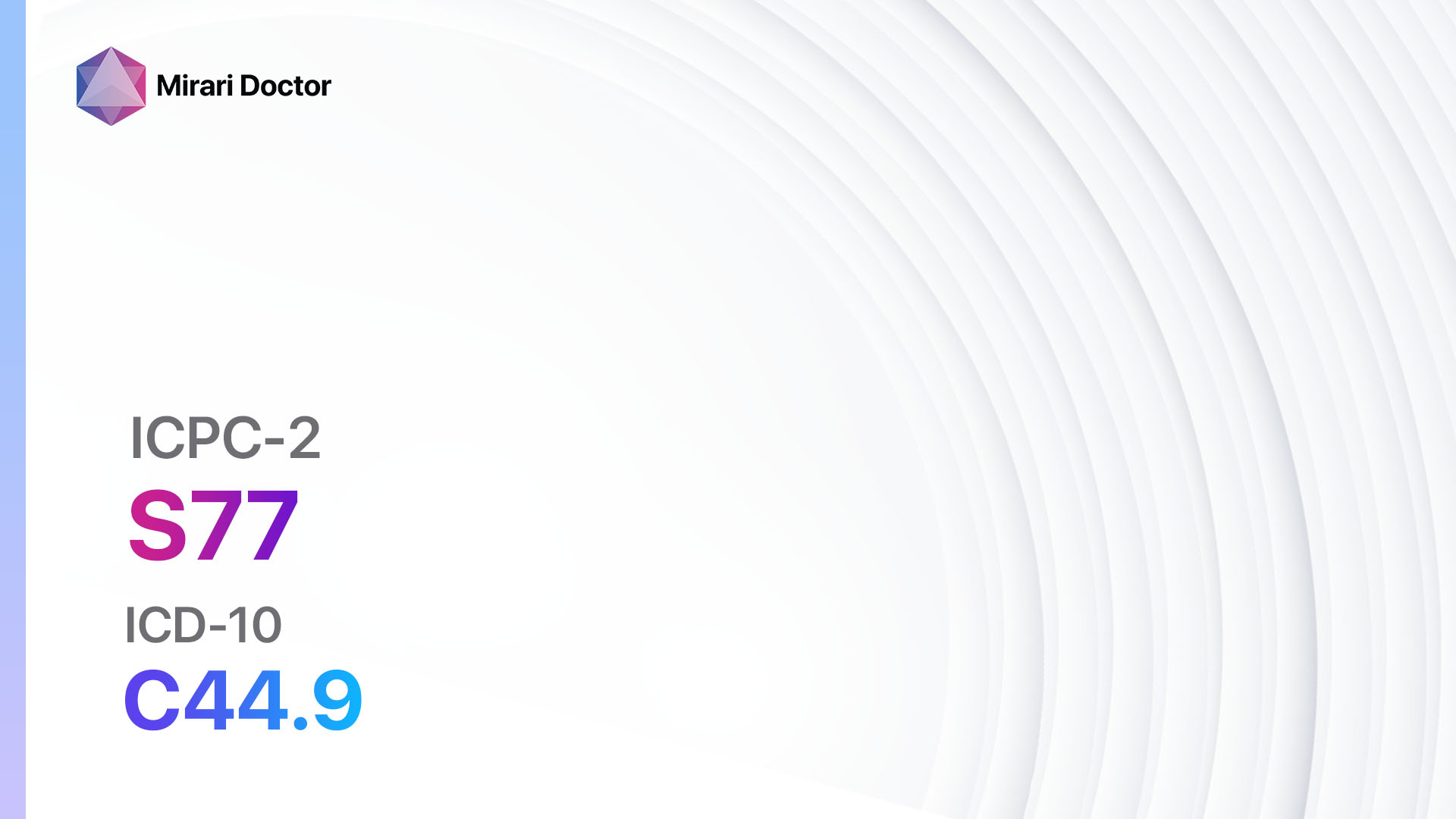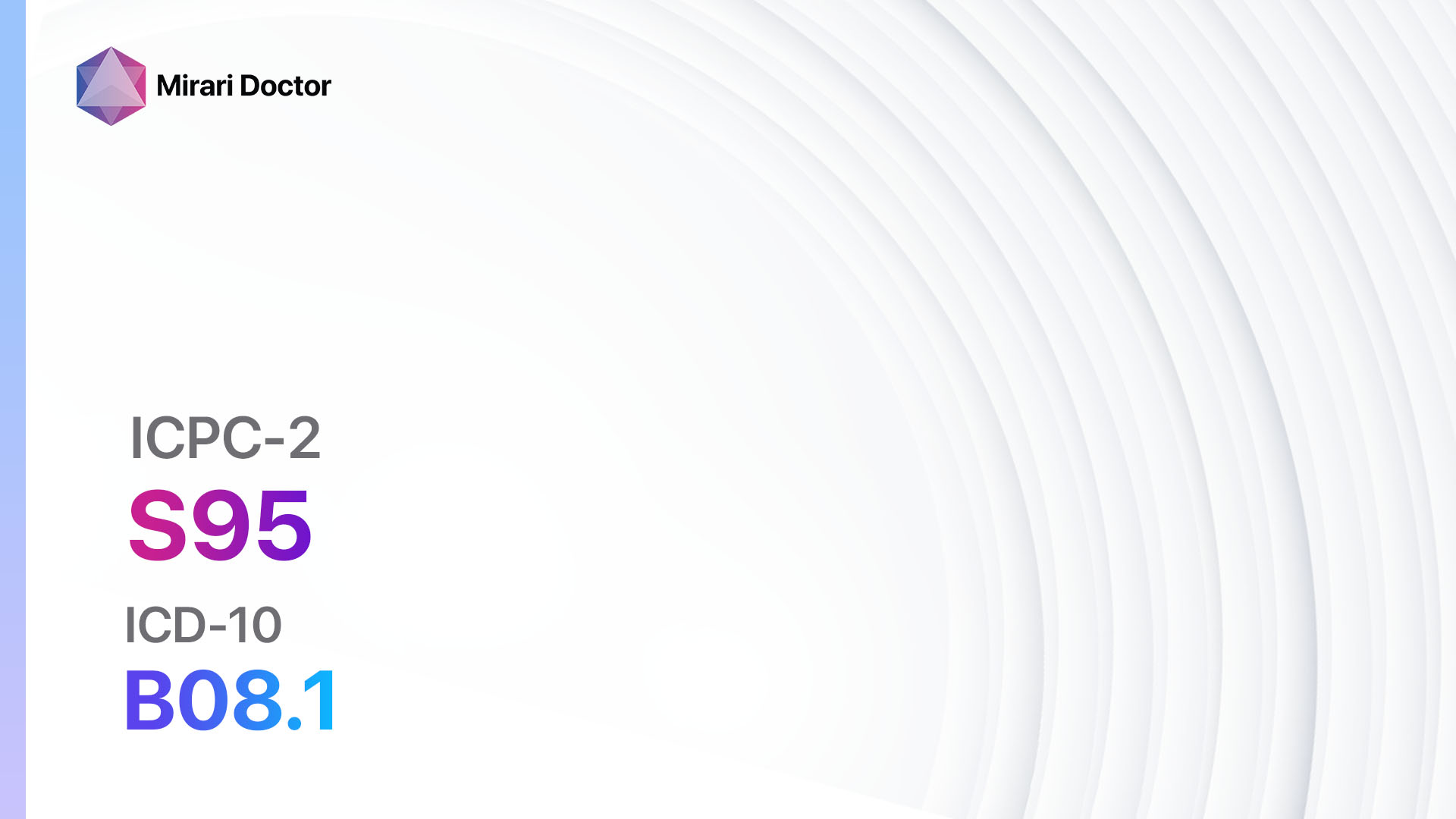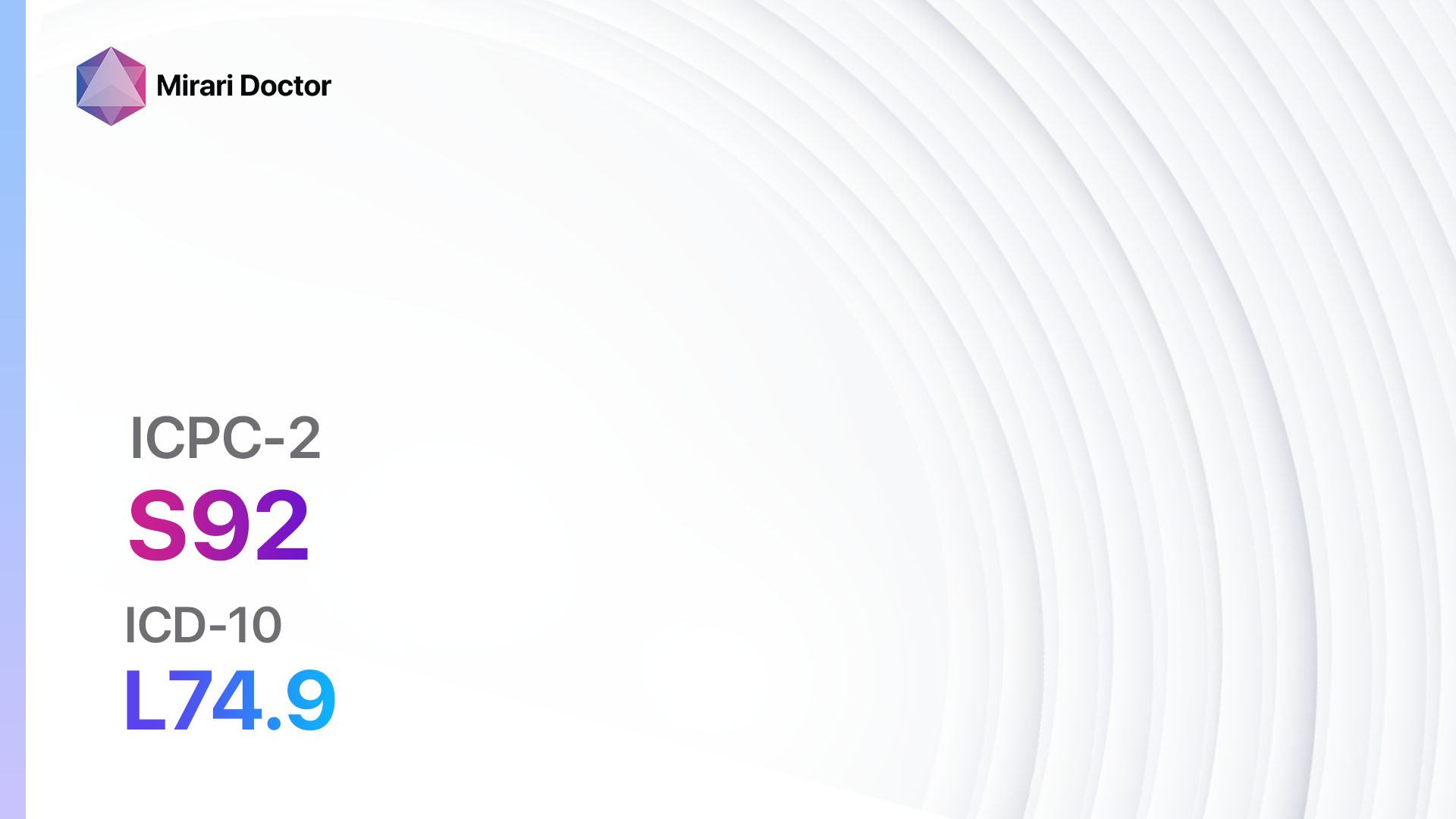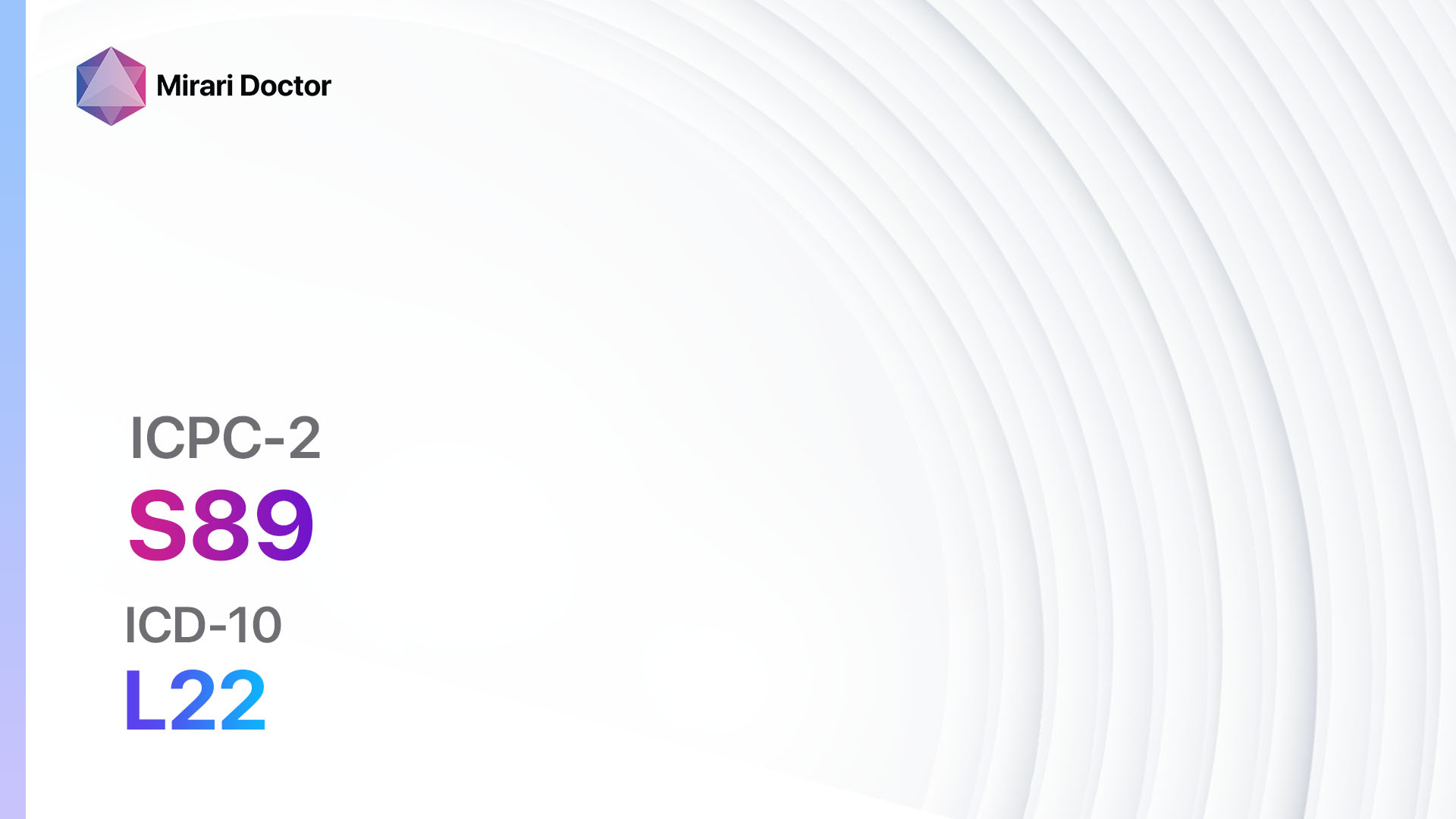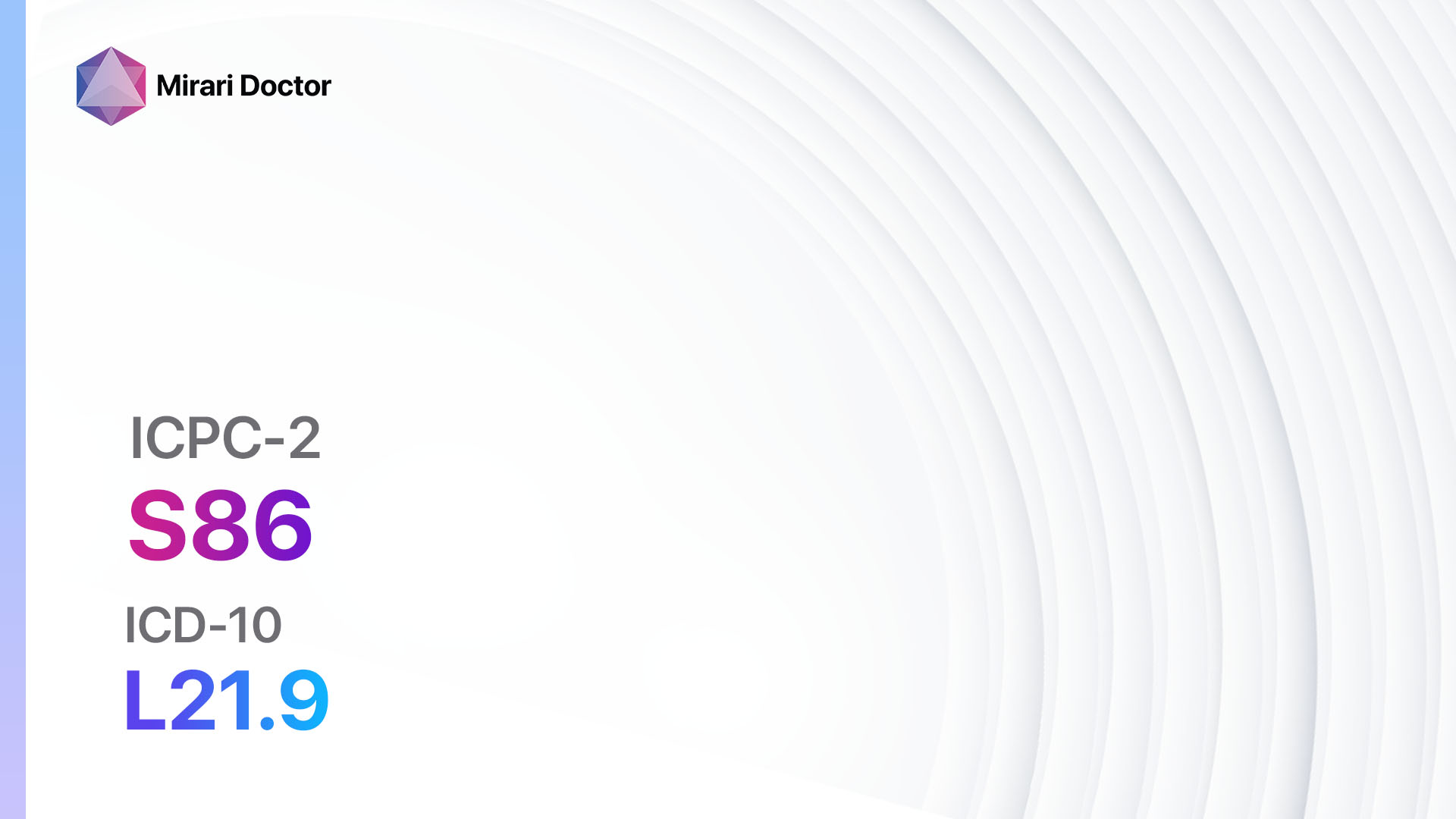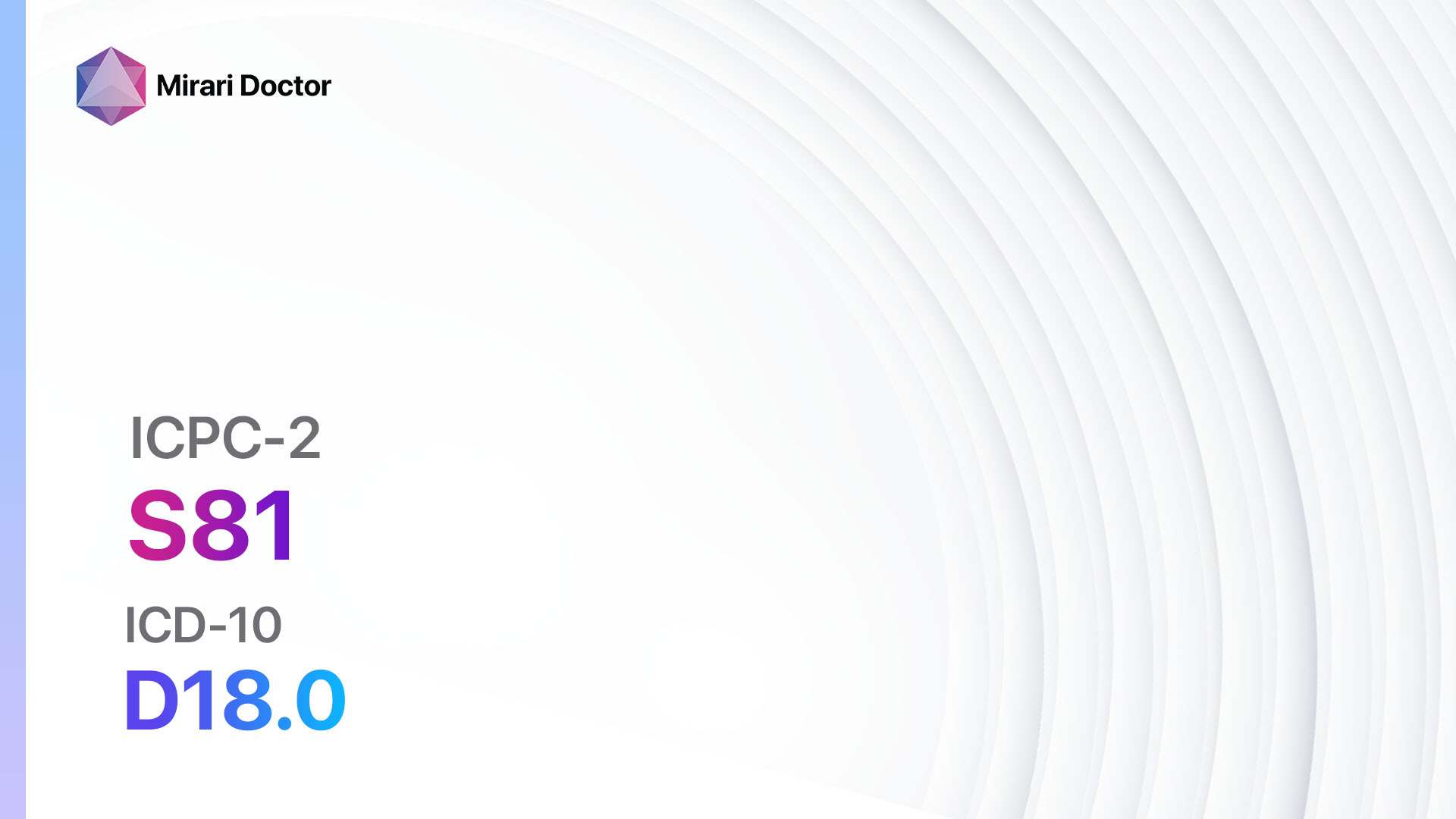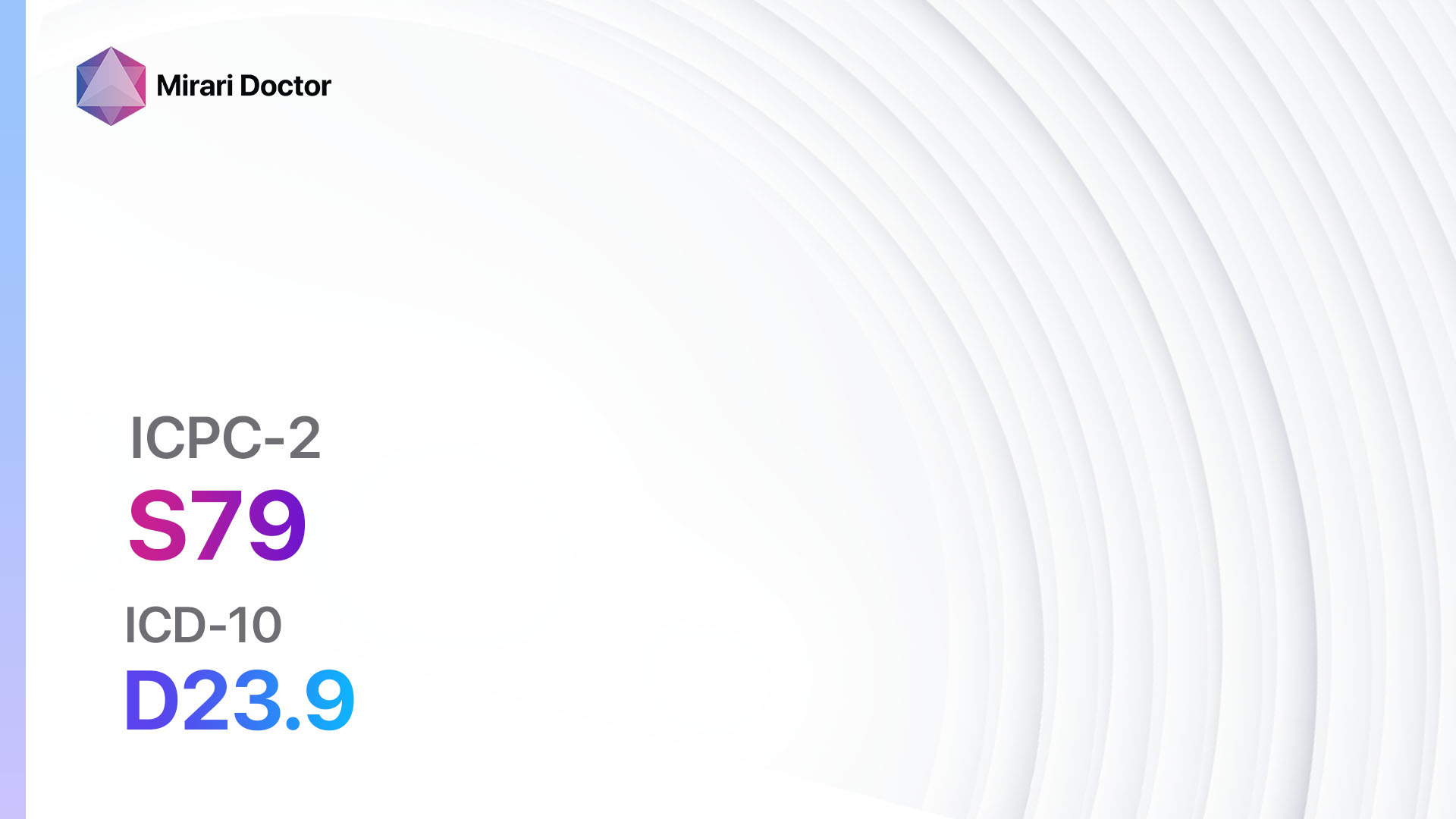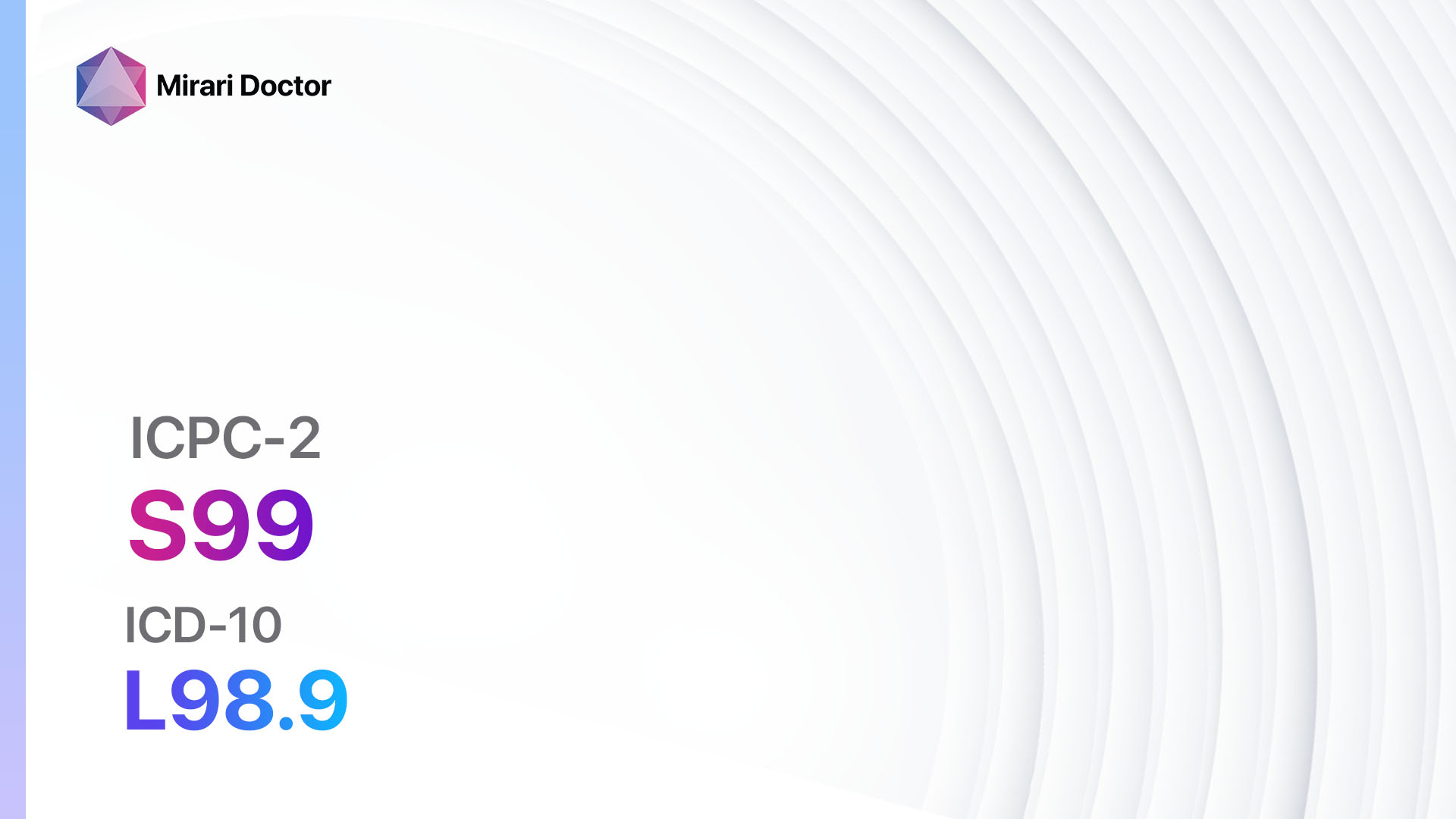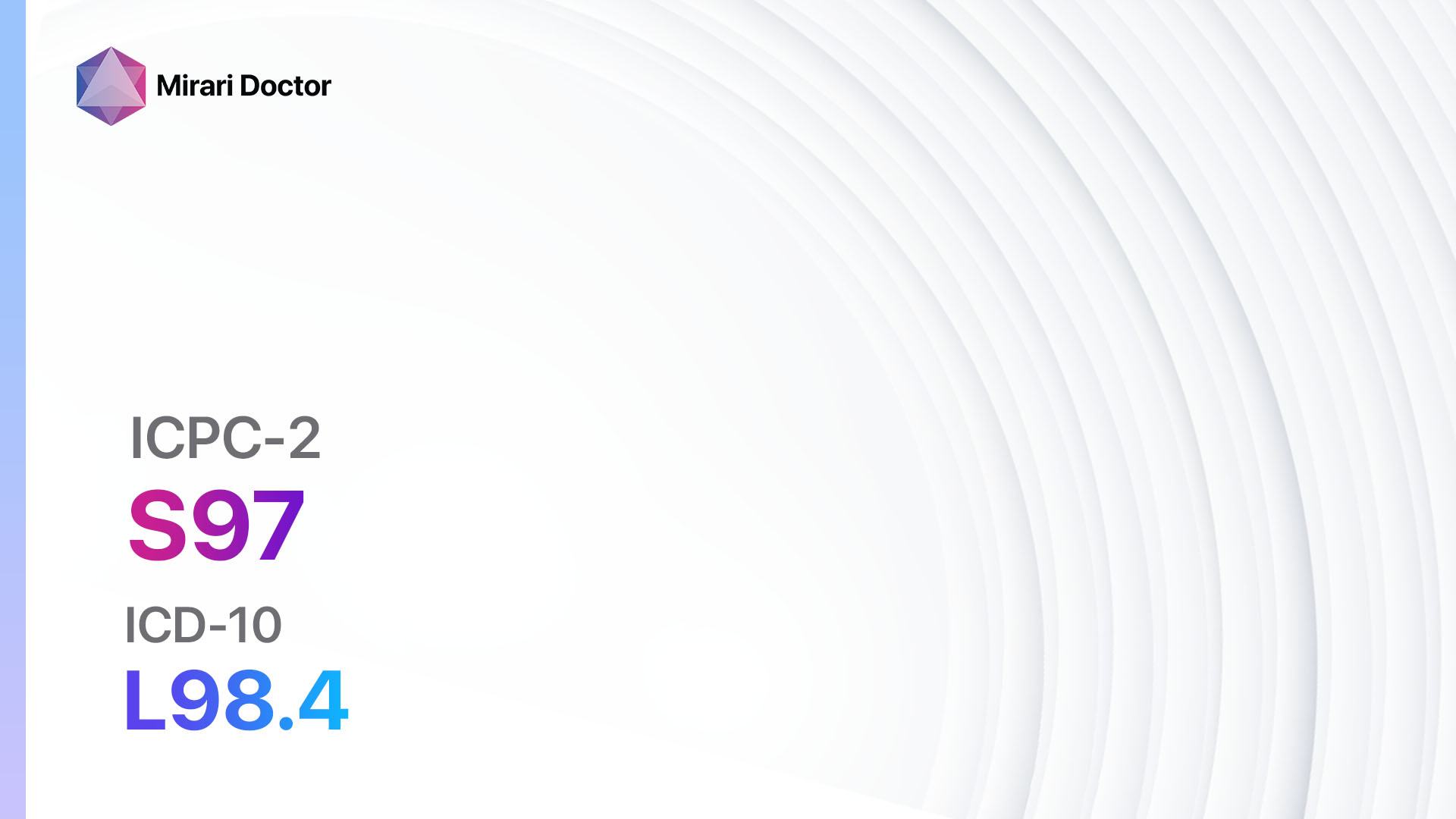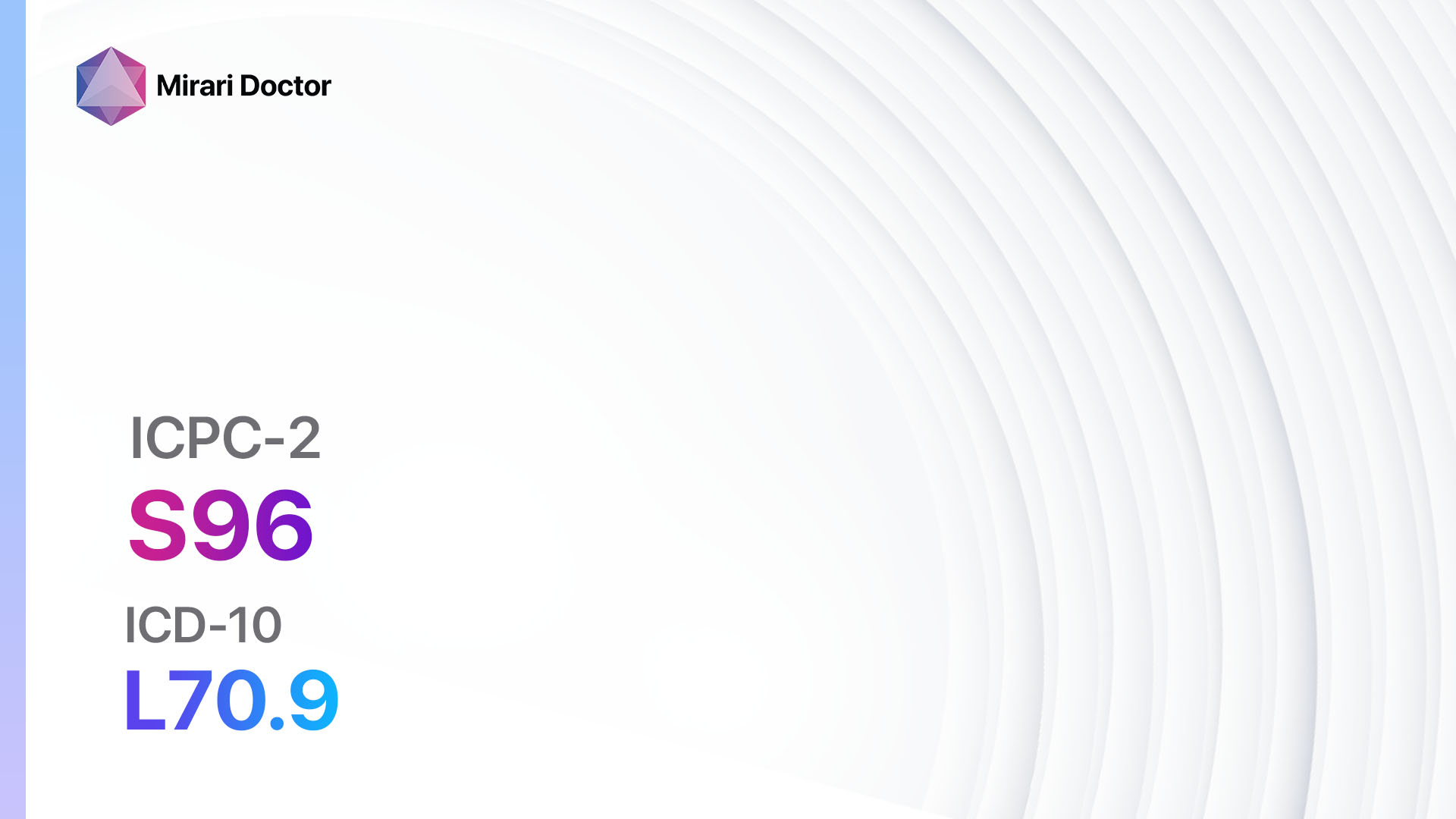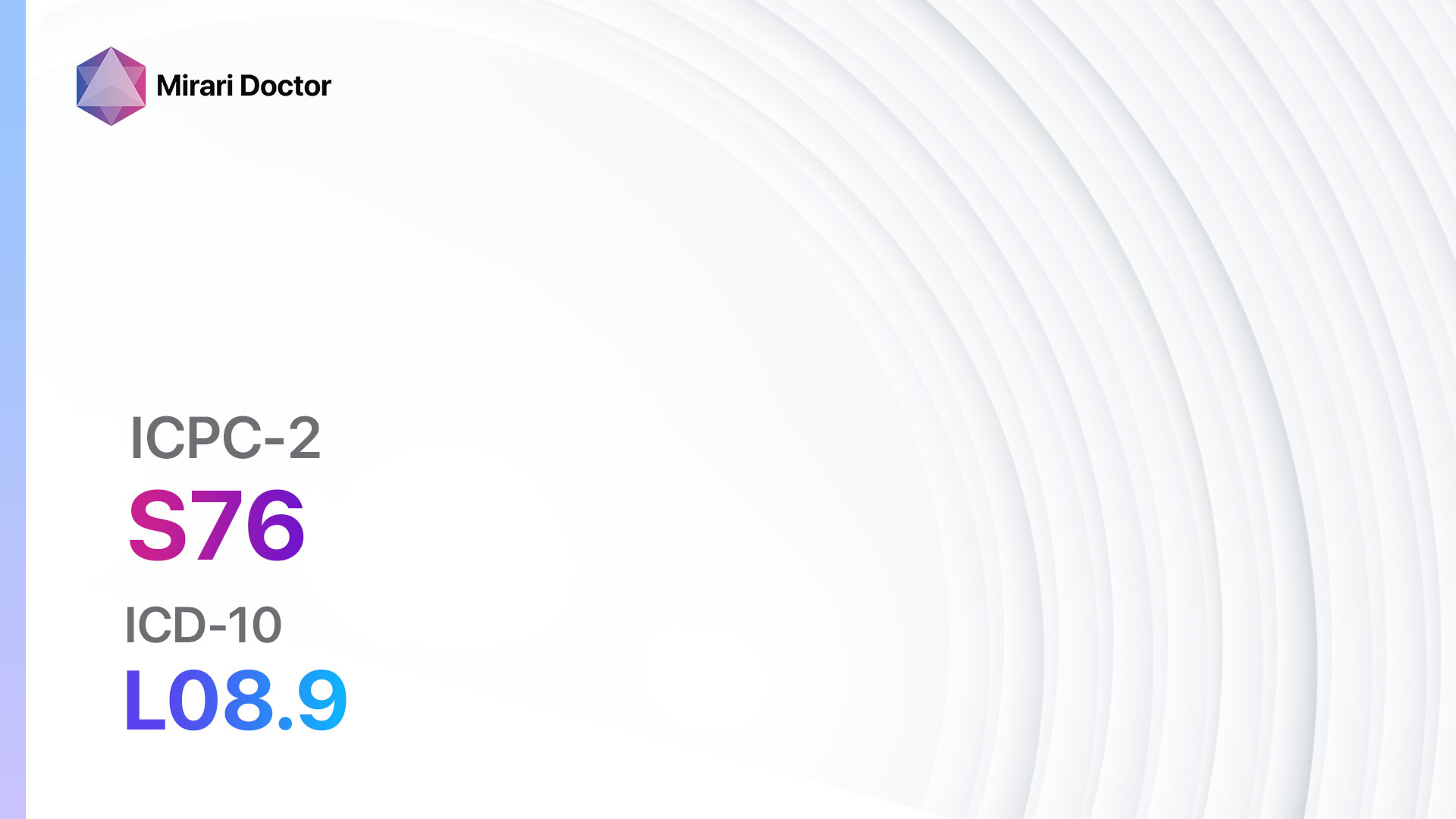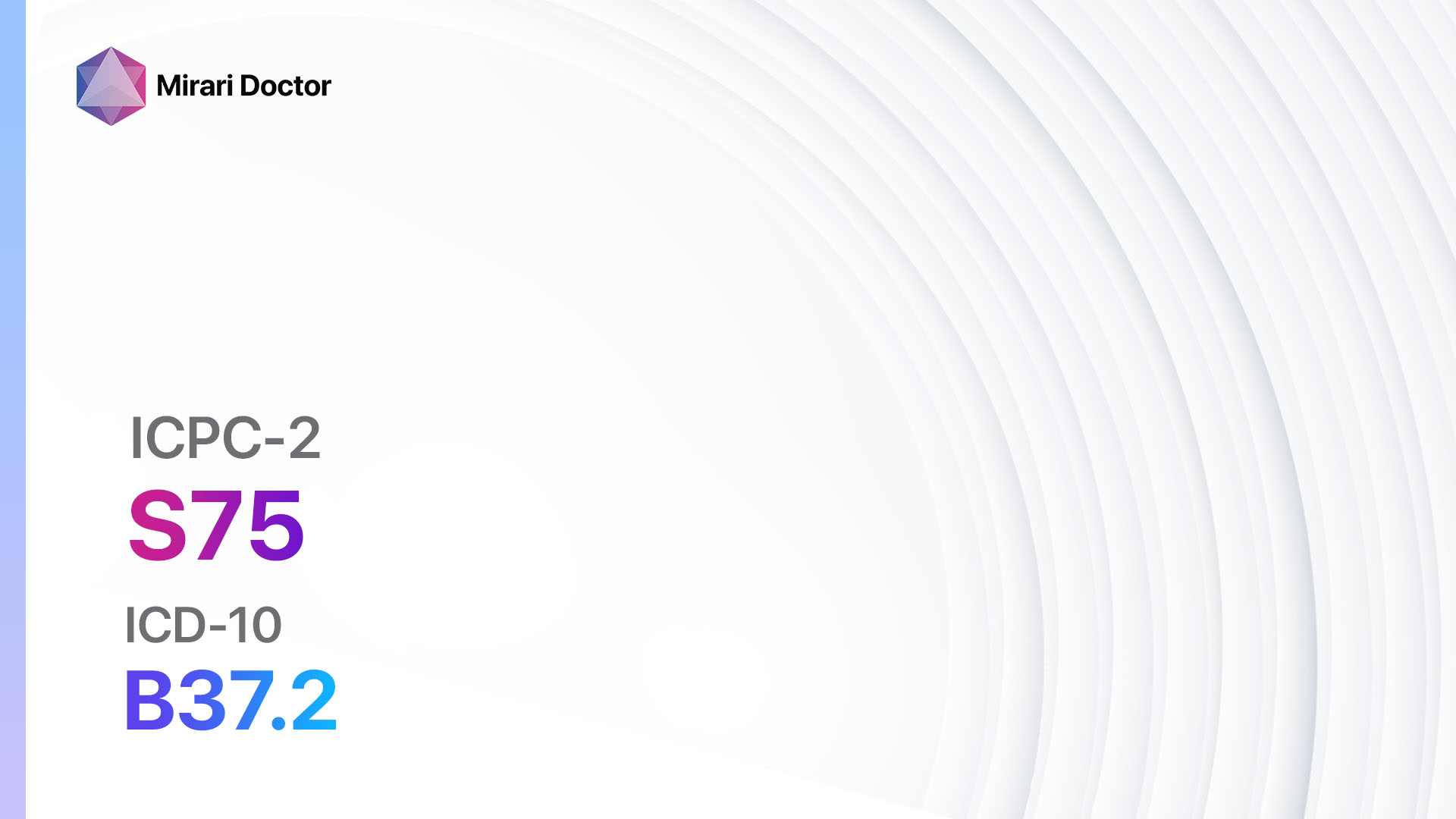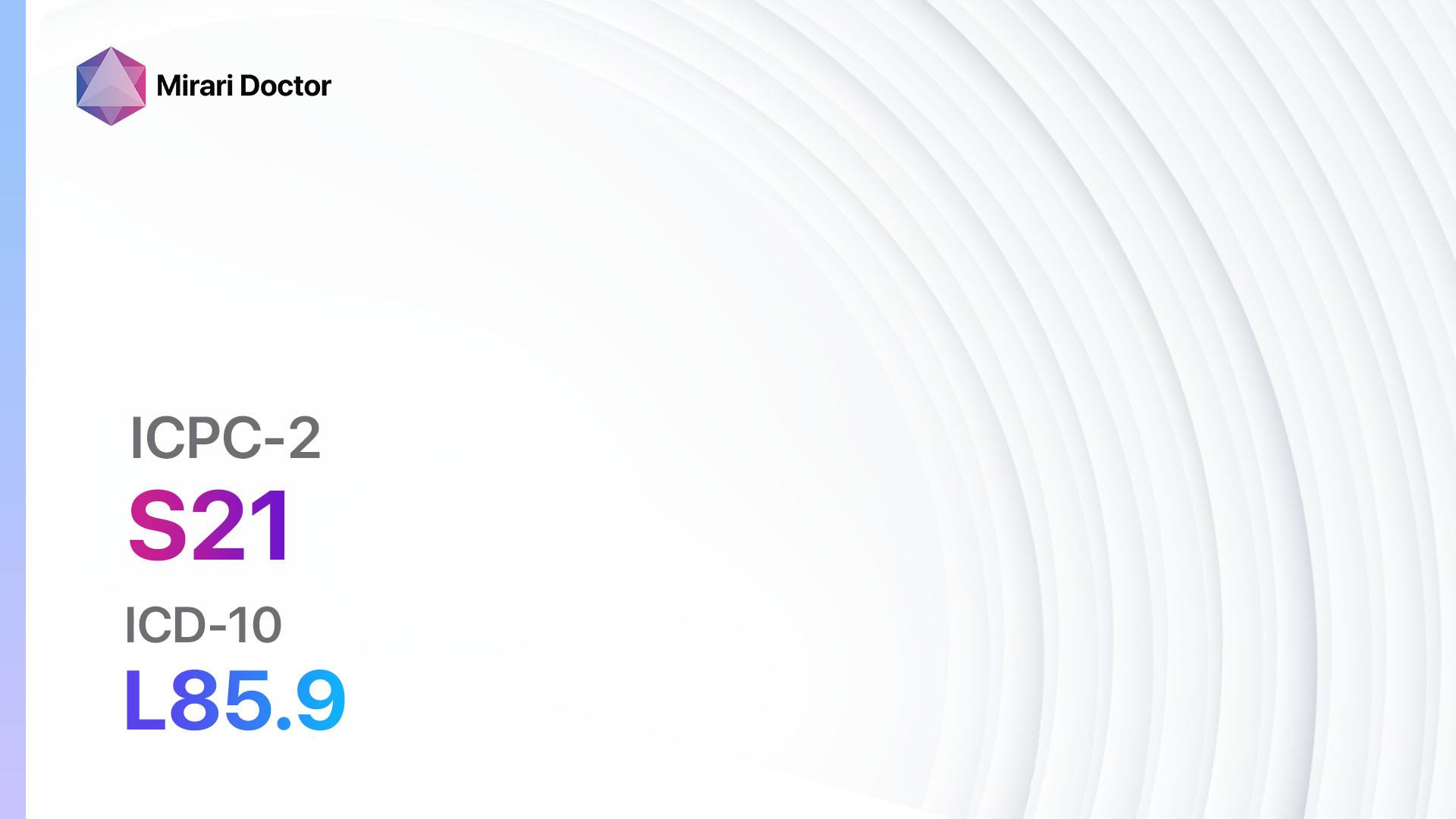
Introduction
Skin texture refers to the overall appearance and feel of the skin. Changes in skin texture can be indicative of various underlying conditions or diseases[1]. This guide aims to provide a comprehensive approach to diagnosing and managing skin texture symptoms/complaints.
Codes
- ICPC-2 Code: S21 Skin texture symptom/complaint[2]
- ICD-10 Code: L85.9 Epidermal thickening, unspecified[3]
Symptoms
- Dryness: Skin feels rough, tight, and may appear flaky or scaly[4].
- Roughness: Skin feels uneven, bumpy, or coarse[5].
- Pitting: Skin has small depressions or pits[6].
- Thickening: Skin feels thicker than usual[7].
- Thinness: Skin feels thin and fragile[8].
- Wrinkling: Skin has fine lines or wrinkles[9].
Causes
- Aging: Natural aging process can lead to changes in skin texture[10].
- Environmental factors: Exposure to harsh weather conditions, pollution, or excessive sun exposure.
- Skin conditions: Conditions like eczema, psoriasis, or dermatitis can affect skin texture.
- Hormonal changes: Hormonal imbalances or fluctuations can impact skin texture.
- Nutritional deficiencies: Lack of essential nutrients can affect skin health.
- Medications: Certain medications can cause changes in skin texture.
Diagnostic Steps
Medical History
- Gather information about the patient’s age, gender, and occupation.
- Ask about any known medical conditions, such as eczema, psoriasis, or dermatitis.
- Inquire about any recent changes in skincare routine or exposure to environmental factors.
- Assess the patient’s overall health and any relevant medical history, such as hormonal imbalances or nutritional deficiencies.
Physical Examination
- Inspect the skin for dryness, roughness, pitting, thickening, thinness, or wrinkling.
- Palpate the skin to assess its texture and thickness.
- Examine any specific areas of concern, such as the face, hands, or feet.
- Evaluate the skin’s elasticity and turgor.
Determine Severity
- Classify the skin texture symptom/complaint based on severity and depth, if applicable:
- Mild: Minimal changes in skin texture, with no significant impact on daily activities.
- Moderate: Noticeable changes in skin texture, causing mild discomfort or cosmetic concerns.
- Severe: Pronounced changes in skin texture, leading to significant functional impairment or psychological distress.
Laboratory Tests
- Complete blood count (CBC): To assess for any underlying nutritional deficiencies or systemic conditions.
- Thyroid function tests: To evaluate thyroid hormone levels, as hormonal imbalances can affect skin texture.
- Allergy testing: If suspected, to identify any potential allergens triggering skin texture changes.
- Skin biopsy: In some cases, a small sample of skin may be taken for further analysis.
Diagnostic Imaging
- No diagnostic imaging is typically necessary for skin texture symptoms/complaints.
Other Tests
- Patch testing: If allergic contact dermatitis is suspected, patch testing can help identify specific allergens.
- Skin scraping or culture: If there is a suspicion of a fungal or bacterial infection, a sample may be taken for analysis.
Follow-up and Patient Education
- Schedule a follow-up appointment to monitor the progress of treatment and assess any changes in skin texture.
- Provide patient education on proper skincare routines, including moisturizing, sun protection, and avoiding harsh environmental factors.
- Discuss the importance of maintaining a healthy lifestyle, including a balanced diet and regular exercise, for overall skin health.
Possible Interventions
Traditional Interventions
Medications:
Top 5 drugs for improving skin texture:
- Topical retinoids (e.g., Tretinoin, Adapalene):
- Cost: $20-$100 per tube.
- Contraindications: Pregnancy, breastfeeding, hypersensitivity to retinoids.
- Side effects: Dryness, redness, peeling.
- Severe side effects: Severe skin irritation, allergic reactions.
- Drug interactions: None significant.
- Warning: Use sunscreen and avoid excessive sun exposure.
- Moisturizers (e.g., Ceramide-based moisturizers, Hyaluronic acid-based moisturizers):
- Cost: $5-$30 per bottle.
- Contraindications: Hypersensitivity to specific ingredients.
- Side effects: None significant.
- Severe side effects: None reported.
- Drug interactions: None significant.
- Warning: Choose a moisturizer suitable for the individual’s skin type.
- Topical corticosteroids (e.g., Hydrocortisone, Betamethasone):
- Cost: $5-$30 per tube.
- Contraindications: Active skin infections, hypersensitivity to corticosteroids.
- Side effects: Skin thinning, discoloration, increased hair growth.
- Severe side effects: Rare but can include adrenal suppression or allergic reactions.
- Drug interactions: None significant.
- Warning: Use under the guidance of a healthcare professional and for a limited duration.
- Antifungal creams (e.g., Clotrimazole, Miconazole):
- Cost: $5-$20 per tube.
- Contraindications: Hypersensitivity to antifungal agents.
- Side effects: Skin irritation, redness.
- Severe side effects: Severe allergic reactions.
- Drug interactions: None significant.
- Warning: Use as directed and continue treatment for the recommended duration.
- Systemic antibiotics (e.g., Doxycycline, Azithromycin):
- Cost: $10-$50 per course.
- Contraindications: Hypersensitivity to antibiotics, pregnancy, breastfeeding.
- Side effects: Nausea, diarrhea, photosensitivity.
- Severe side effects: Rare but can include severe allergic reactions or antibiotic-associated colitis.
- Drug interactions: None significant.
- Warning: Use under the guidance of a healthcare professional and complete the full course of treatment.
Alternative Drugs:
- Alpha hydroxy acids (e.g., Glycolic acid, Lactic acid): Exfoliating agents that can improve skin texture.
- Vitamin C serums: Antioxidant-rich serums that can promote collagen production and improve skin texture.
- Niacinamide: A form of vitamin B3 that can help improve skin texture and reduce inflammation.
- Peptide creams: Creams containing peptides that can stimulate collagen production and improve skin texture.
- Antioxidant-rich creams: Creams containing antioxidants like green tea extract or resveratrol that can improve skin health.
Surgical Procedures:
- Surgical procedures are not typically indicated for skin texture symptoms/complaints.
Alternative Interventions
- Microdermabrasion: A non-invasive procedure that exfoliates the skin to improve texture. Cost: $100-$200 per session.
- Chemical peels: A procedure that uses chemical solutions to remove the outer layer of skin, improving texture. Cost: $100-$500 per session.
- Laser resurfacing: A procedure that uses laser technology to remove damaged skin and stimulate collagen production. Cost: $500-$2,000 per session.
- Microneedling: A procedure that uses tiny needles to create controlled micro-injuries, promoting collagen production and improving skin texture. Cost: $200-$500 per session.
- Radiofrequency skin tightening: A procedure that uses radiofrequency energy to tighten the skin and improve texture. Cost: $500-$1,500 per session.
Lifestyle Interventions
- Healthy diet: Encourage a diet rich in fruits, vegetables, whole grains, and lean proteins to provide essential nutrients for skin health. Cost: Varies depending on food choices.
- Hydration: Emphasize the importance of drinking an adequate amount of water daily to maintain skin hydration. Cost: Minimal.
- Sun protection: Advise the use of sunscreen with at least SPF 30 and protective clothing to prevent sun damage. Cost: $10-$30 per bottle.
- Avoid smoking: Educate patients on the harmful effects of smoking on skin health and encourage smoking cessation. Cost: Varies depending on cessation methods.
- Stress management: Recommend stress-reducing techniques, such as exercise, meditation, or counseling, as stress can impact skin health. Cost: Varies depending on chosen methods.
It is important to note that the cost ranges provided are approximate and may vary depending on the location and availability of the interventions.
Mirari Cold Plasma Alternative Intervention
Understanding Mirari Cold Plasma
- Safe and Non-Invasive Treatment: Mirari Cold Plasma is a safe and non-invasive treatment option for various skin conditions. It does not require incisions, minimizing the risk of scarring, bleeding, or tissue damage.
- Efficient Extraction of Foreign Bodies: Mirari Cold Plasma facilitates the removal of foreign bodies from the skin by degrading and dissociating organic matter, allowing easier access and extraction.
- Pain Reduction and Comfort: Mirari Cold Plasma has a local analgesic effect, providing pain relief during the treatment, making it more comfortable for the patient.
- Reduced Risk of Infection: Mirari Cold Plasma has antimicrobial properties, effectively killing bacteria and reducing the risk of infection.
- Accelerated Healing and Minimal Scarring: Mirari Cold Plasma stimulates wound healing and tissue regeneration, reducing healing time and minimizing the formation of scars.
Mirari Cold Plasma Prescription
Video instructions for using Mirari Cold Plasma Device – S21 Skin texture symptom/complaint (ICD-10:L85.9)
| Mild | Moderate | Severe |
| Mode setting: 1 (Infection) Location: 0 (Localized) Morning: 15 minutes, Evening: 15 minutes |
Mode setting: 1 (Infection) Location: 0 (Localized) Morning: 30 minutes, Lunch: 30 minutes, Evening: 30 minutes |
Mode setting: 1 (Infection) Location: 0 (Localized) Morning: 30 minutes, Lunch: 30 minutes, Evening: 30 minutes |
| Mode setting: 10 (Dermatitis/Fungus) Location: 0 (Localized) Morning: 15 minutes, Evening: 15 minutes |
Mode setting: 10 (Dermatitis/Fungus) Location: 0 (Localized) Morning: 30 minutes, Lunch: 30 minutes, Evening: 30 minutes |
Mode setting: 10 (Dermatitis/Fungus) Location: 0 (Localized) Morning: 30 minutes, Lunch: 30 minutes, Evening: 30 minutes |
| Total Morning: 30 minutes approx. $5 USD, Evening: 30 minutes approx. $5 USD |
Total Morning: 60 minutes approx. $10 USD, Lunch: 60 minutes approx. $10 USD, Evening: 60 minutes approx. $10 USD |
Total Morning: 60 minutes approx. $10 USD, Lunch: 60 minutes approx. $10 USD, Evening: 60 minutes approx. $10 USD |
| Usual treatment for 7-60 days approx. $70 USD – $600 USD | Usual treatment for 6-8 weeks approx. $1,260 USD – $1,680 USD | Usual treatment for 3-6 months approx. $2,700 USD – $5,400 USD |
 |
|
Use the Mirari Cold Plasma device to treat Skin texture symptom/complaint effectively.
WARNING: MIRARI COLD PLASMA IS DESIGNED FOR THE HUMAN BODY WITHOUT ANY ARTIFICIAL OR THIRD PARTY PRODUCTS. USE OF OTHER PRODUCTS IN COMBINATION WITH MIRARI COLD PLASMA MAY CAUSE UNPREDICTABLE EFFECTS, HARM OR INJURY. PLEASE CONSULT A MEDICAL PROFESSIONAL BEFORE COMBINING ANY OTHER PRODUCTS WITH USE OF MIRARI.
Step 1: Cleanse the Skin
- Start by cleaning the affected area of the skin with a gentle cleanser or mild soap and water. Gently pat the area dry with a clean towel.
Step 2: Prepare the Mirari Cold Plasma device
- Ensure that the Mirari Cold Plasma device is fully charged or has fresh batteries as per the manufacturer’s instructions. Make sure the device is clean and in good working condition.
- Switch on the Mirari device using the power button or by following the specific instructions provided with the device.
- Some Mirari devices may have adjustable settings for intensity or treatment duration. Follow the manufacturer’s instructions to select the appropriate settings based on your needs and the recommended guidelines.
Step 3: Apply the Device
- Place the Mirari device in direct contact with the affected area of the skin. Gently glide or hold the device over the skin surface, ensuring even coverage of the area experiencing.
- Slowly move the Mirari device in a circular motion or follow a specific pattern as indicated in the user manual. This helps ensure thorough treatment coverage.
Step 4: Monitor and Assess:
- Keep track of your progress and evaluate the effectiveness of the Mirari device in managing your Skin texture symptom/complaint. If you have any concerns or notice any adverse reactions, consult with your health care professional.
Note
This guide is for informational purposes only and should not replace the advice of a medical professional. Always consult with your healthcare provider or a qualified medical professional for personal advice, diagnosis, or treatment. Do not solely rely on the information presented here for decisions about your health. Use of this information is at your own risk. The authors of this guide, nor any associated entities or platforms, are not responsible for any potential adverse effects or outcomes based on the content.
Mirari Cold Plasma System Disclaimer
- Purpose: The Mirari Cold Plasma System is a Class 2 medical device designed for use by trained healthcare professionals. It is registered for use in Thailand and Vietnam. It is not intended for use outside of these locations.
- Informational Use: The content and information provided with the device are for educational and informational purposes only. They are not a substitute for professional medical advice or care.
- Variable Outcomes: While the device is approved for specific uses, individual outcomes can differ. We do not assert or guarantee specific medical outcomes.
- Consultation: Prior to utilizing the device or making decisions based on its content, it is essential to consult with a Certified Mirari Tele-Therapist and your medical healthcare provider regarding specific protocols.
- Liability: By using this device, users are acknowledging and accepting all potential risks. Neither the manufacturer nor the distributor will be held accountable for any adverse reactions, injuries, or damages stemming from its use.
- Geographical Availability: This device has received approval for designated purposes by the Thai and Vietnam FDA. As of now, outside of Thailand and Vietnam, the Mirari Cold Plasma System is not available for purchase or use.
References
- Farage, M. A., Miller, K. W., Elsner, P., & Maibach, H. I. (2013). Characteristics of the Aging Skin. Advances in Wound Care, 2(1), 5–10.
- WONCA International Classification Committee. (1998). ICPC-2: International Classification of Primary Care. Oxford University Press, USA.
- World Health Organization. (2019). International Statistical Classification of Diseases and Related Health Problems (11th ed.).
- Rawlings, A. V., & Harding, C. R. (2004). Moisturization and skin barrier function. Dermatologic Therapy, 17(s1), 43-48.
- Lagarde, J. M., Rouvrais, C., & Black, D. (2005). Topography and anisotropy of the skin surface with ageing. Skin Research and Technology, 11(2), 110-119.
- Firooz, A., Sadr, B., Babakoohi, S., Sarraf-Yazdy, M., Fanian, F., Kazerouni-Timsar, A., … & Dowlati, Y. (2012). Variation of biophysical parameters of the skin with age, gender, and body region. The Scientific World Journal, 2012.
- Waller, J. M., & Maibach, H. I. (2005). Age and skin structure and function, a quantitative approach (I): blood flow, pH, thickness, and ultrasound echogenicity. Skin Research and Technology, 11(4), 221-235.
- Waller, J. M., & Maibach, H. I. (2006). Age and skin structure and function, a quantitative approach (II): protein, glycosaminoglycan, water, and lipid content and structure. Skin Research and Technology, 12(3), 145-154.
- Ganceviciene, R., Liakou, A. I., Theodoridis, A., Makrantonaki, E., & Zouboulis, C. C. (2012). Skin anti-aging strategies. Dermato-endocrinology, 4(3), 308-319.
- Tobin, D. J. (2017). Introduction to skin aging. Journal of Tissue Viability, 26(1), 37-46.
Related articles
Made in USA



